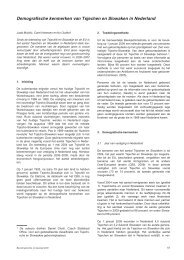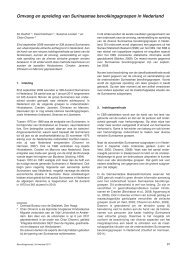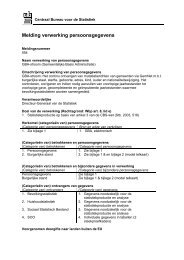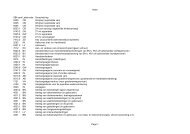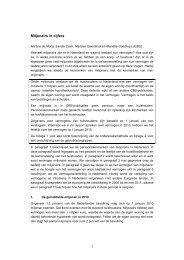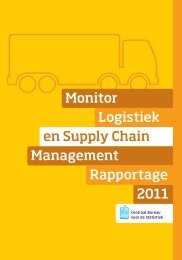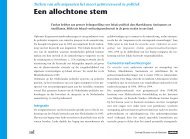1.3 Geographical composition of Dutch international trade in commodities Table 1.3.1 shows the Dutch trade pattern with its main trading partners for 2008–2011. The bulk of Dutch trade takes place with the other countries of the European Union. In 2011, more than half of the Dutch imports originated from EU countries, and almost 75 percent of Dutch exports were destined for an EU country. Germany is still the most important trading partner. Compared with 15 years ago, the role of the EU in Dutch exports has changed relatively little, but in terms of imports the picture has changed somewhat. In 1996, almost 65 percent of Dutch imports came from an EU country (and at that time the EU counted only 14 other Member States, compared with the 26 other member states in 2011). The main reason for the declining importance of the EU is still the rise of China and the other emerging markets such as Brazil and Russia. The share of imports coming from BRIC countries, most importantly China, has quadrupled since 1996, coming from 4 percent to almost 16 percent or 57.0 billion euros in 2011. Dutch exports to BRIC countries also increased, but at a much slower pace. EU-members are still the most important trading partners for the Netherlands 30 Statistics Netherlands A study on international trade data for the year 2010 showed that the value of trade between the Netherlands and its different trading partners can be predicted quite well by the GDP of the trading partner and the geographical distance from the trading partner (Ramaekers & De Wit, <strong>2012</strong>). That is, a higher GDP correlates with a higher trade value, whereas distance is negatively correlated with trade value. For the Netherlands, these two factors account for 85 percent of the variability of the trade value between trading partners. The study also shows that, taking these factors into account, trade with Germany is not exceptionally high. Trade with the Netherlands is larger than expected for countries like Belgium, China and Taiwan. Factors like openness of an economy, re-exports and specific export products play a key role in this. However, trade value is lower than expected for most large economies, e.g. Canada. Here, the fact that large economies are more self-providing plays an important role. There is also less trade with politically instable countries.
1.3.1 International trade in goods by partner country Import value Export value 2008 2009 2010 2011 2008 2009 2010 2011 million euro Total 335,927 274,025 331,914 364,922 370,489 309,369 371,549 409,358 EU 185,128 151,826 176,670 193,565 282,735 231,344 275,666 302,883 Belgium 33,896 27,452 31,864 36,420 42,967 34,620 41,265 48,678 Czech Republic 3,701 3,761 4,544 5,154 4,481 3,818 5,317 5,947 France 16,885 13,591 14,438 16,785 32,376 27,484 32,489 36,245 Germany 64,622 52,538 58,914 60,943 90,618 75,225 90,269 99,189 Italy 7,962 6,322 7,163 7,786 19,609 16,007 18,596 19,528 Poland 3,939 3,595 4,624 5,094 7,261 5,948 7,378 8,411 Spain 5,989 4,799 7,037 6,564 12,731 10,512 12,604 12,234 Sweden 5,737 3,993 5,282 6,238 6,463 5,185 6,650 7,194 United Kingdom 21,224 17,648 22,130 24,505 33,586 25,879 29,651 32,326 Other EU 21,169 18,126 20,675 24,076 32,640 26,659 31,447 33,131 BRIC 45,208 37,877 52,714 57,036 13,208 11,784 14,546 17,247 Brazil 4,854 3,893 4,397 5,612 1,231 1,109 1,797 2,282 China 25,000 21,967 31,001 30,874 3,852 4,589 5,391 6,696 India 2,318 2,390 3,293 3,591 1,565 1,668 1,717 1,864 Russia 13,036 9,628 14,023 16,959 6,559 4,419 5,641 6,405 Non-EU (excl. BRIC) 105,594 84,324 102,529 114,321 74,551 66,249 81,337 89,228 Japan 9,492 7,251 9,275 10,100 2,945 2,381 3,190 3,414 United States 27,043 22,995 25,055 23,541 16,472 13,928 16,875 19,632 Rest of world 69,059 54,078 68,200 80,680 55,134 49,939 61,273 66,182 Source: <strong>CBS</strong>, Statline, International trade in goods (extracted: 2-9-<strong>2012</strong>). 1.4 Products traded Table 1.4.1 specifies which goods were imported, exported and re-exported between 2008 and the first quarter of <strong>2012</strong>. With 103.0 billion euro, imports of machinery and transport equipment formed the bulk of Dutch imports in 2011, followed by mineral fuels (80.0 billion) and chemicals (47.0 billion euro). Combined, these three categories accounted for 63 percent of Dutch imports in 2011. Dutch export products quite resemble the imports, with machinery and transport equipment, chemicals and mineral fuels as the largest categories. <strong>Internationalisation</strong> Monitor <strong>2012</strong> 31
- Page 1 and 2: Internationalisation Monitor 2012
- Page 3 and 4: Foreword This fifth edition of the
- Page 5 and 6: Contents Foreword 3 Introduction: t
- Page 7: 10 International trade in goods by
- Page 11 and 12: Introduction: the Internationalisat
- Page 13 and 14: In each edition of the Internationa
- Page 15 and 16: indicate that Dutch enterprises sti
- Page 17 and 18: deepening already existing relation
- Page 19: new jobs and sustainable growth. Re
- Page 23 and 24: Trends in international trade in go
- Page 25 and 26: 1.2 Trends in trade and the economi
- Page 27 and 28: The international trade in goods is
- Page 29: 1.2.5 Development of Dutch GDP; imp
- Page 33 and 34: The Netherlands seeks to expand kno
- Page 35 and 36: 1.4.4 Geographical composition of e
- Page 37 and 38: Table 1.5.2 shows the five main tra
- Page 39 and 40: 1.5.4 Geographical composition of r
- Page 41: 1.1.1a Annex Annex Level Descriptio
- Page 45 and 46: A closer look at BRIC traders 2.1 2
- Page 47 and 48: the characteristics of firms active
- Page 49 and 50: About 80 percent of the importers i
- Page 51 and 52: Table 2.3.4 shows BRIC trade by sec
- Page 53 and 54: Comparing BRIC traders to the avera
- Page 55 and 56: 2.4.1 Relation of BRIC trade to fir
- Page 57 and 58: egressions as in tables 2.4.1 and 2
- Page 59 and 60: Likelihood of BRIC trade Finally, a
- Page 61: 2.5 Conclusions This chapter analys
- Page 65 and 66: Trends in the international trade i
- Page 67 and 68: The overall Dutch import and export
- Page 69 and 70: 3.3.2 (imports) and 3.3.3 (exports)
- Page 71 and 72: 3.4.1 Share of business and persona
- Page 73 and 74: 0 2006 exported service to these tw
- Page 75 and 76: services. For Brazil and Australia
- Page 77 and 78: 3.7.3 Total import values of servic
- Page 79: Trends in foreign investments
- Page 82 and 83:
This chapter presents the latest da
- Page 84 and 85:
Graph 4.2.1 shows that FDI flows fl
- Page 86 and 87:
4.2.3 Inward and outward FDI, by kn
- Page 88 and 89:
4.3.1 Share of foreign controlled e
- Page 90 and 91:
4.4 Dutch controlled enterprises ou
- Page 92 and 93:
4.4.3 Turnover of Dutch controlled
- Page 94 and 95:
4.4.5 Ratio of turnover outside the
- Page 97:
International enterprises in a regi
- Page 100 and 101:
Internationally active enterprises,
- Page 102 and 103:
5.3 International enterprises in a
- Page 104 and 105:
Local business units owned by a for
- Page 106 and 107:
Graph 5.3.3 shows the share of fore
- Page 108 and 109:
108 Statistics Netherlands Zeeuws-V
- Page 110 and 111:
5.4.3 Local business units of two-w
- Page 112 and 113:
112 Statistics Netherlands However,
- Page 114 and 115:
Table 5.4.9 and 5.4.10 show the int
- Page 116 and 117:
116 Statistics Netherlands Two thir
- Page 118 and 119:
is at foreign controlled local unit
- Page 121 and 122:
Enterprise demography of internatio
- Page 123 and 124:
to its trade portfolio, or by incre
- Page 125 and 126:
We also expect that the internation
- Page 127 and 128:
6.4 Descriptive statistics The demo
- Page 129 and 130:
owner) in the Netherlands and espec
- Page 131 and 132:
6.4.3 Enterprise growth rate of for
- Page 133 and 134:
abroad makes extra demands on an en
- Page 135 and 136:
6.6.1 Survival rates of new start-u
- Page 137 and 138:
6.6.3 Survival rates of new start-u
- Page 139 and 140:
6.7.1 Cox regression model fitted t
- Page 141 and 142:
Annex Births of Dutch and foreign c
- Page 143:
Economic effects of enterprise dyna
- Page 146 and 147:
We studied the development trajecto
- Page 148 and 149:
categories for 2008 alone, because
- Page 150 and 151:
150 Statistics Netherlands group cr
- Page 152 and 153:
Total turnover of the cohort of 200
- Page 154 and 155:
This table only shows some outlines
- Page 156 and 157:
7.4.6 Comparison of similar Dutch a
- Page 158 and 159:
7.5 Economic development before exi
- Page 160 and 161:
7.5.3 Matching variables and refere
- Page 162 and 163:
7.5.5 Development of matched Dutch
- Page 164 and 165:
164 Statistics Netherlands Research
- Page 167 and 168:
Enterprise dynamics and internation
- Page 169 and 170:
We start out by illustrating how ne
- Page 171 and 172:
8.3 Data and methodology In order t
- Page 173 and 174:
8.3.2 Enterprises with product-coun
- Page 175 and 176:
Continuing importers are by far the
- Page 177 and 178:
8.5.2 Trade portfolio at export sta
- Page 179 and 180:
Interesting to see is that both new
- Page 181 and 182:
8.6 Survival analysis In this parag
- Page 183 and 184:
Survival of international traders:
- Page 185 and 186:
8.6.2 Survival rates of new traders
- Page 187 and 188:
8.6.3 Enterprise survival of trader
- Page 189 and 190:
Survival of international traders:
- Page 191 and 192:
8.6.4 Survival rates of new traders
- Page 193 and 194:
Graph 8.6.4 shows that there is onl
- Page 195 and 196:
significant differences. Further an
- Page 197:
8.4a Pairwise comparisons between d
- Page 201 and 202:
Enterprise dynamics during the fina
- Page 203 and 204:
economic activity, size, (foreign)
- Page 205 and 206:
Linking the information on jobs and
- Page 207 and 208:
The birth and death rates as presen
- Page 209 and 210:
9.4 Economic impact of the financia
- Page 211 and 212:
9.4.1 Turnover, jobs, import and ex
- Page 213 and 214:
9.4.2 Dynamics of size classes betw
- Page 215 and 216:
International trade patterns of for
- Page 217 and 218:
9.5 Statistical analysis Our analys
- Page 219 and 220:
9.5.2 Year-on-year (corrected) mean
- Page 221 and 222:
turnover growth over the five years
- Page 223:
International trade in goods by ent
- Page 226 and 227:
This chapter presents information a
- Page 228 and 229:
10.2 Overview of international trad
- Page 230 and 231:
For SMEs that export goods, the sha
- Page 232 and 233:
10.4.1 Import and export value of g
- Page 234 and 235:
10.5.1 Share of importers/exporters
- Page 237 and 238:
International trade in services by
- Page 239 and 240:
11.2 Overview of the international
- Page 241 and 242:
11.3 International trade in service
- Page 243 and 244:
11.4 International trade in service
- Page 245 and 246:
11.4.2 Imports of services by econo
- Page 247:
11.5.1 Share of international servi
- Page 251 and 252:
Foreign Direct Investments 12.1 12.
- Page 253 and 254:
12.2 The Dutch share in worldwide F
- Page 255 and 256:
12.2.2 Dutch share in EU-15 FDI (st
- Page 257 and 258:
12.3.2 Dutch FDI (stocks) relative
- Page 259 and 260:
12.4.1 Dutch FDI (stocks), by count
- Page 261 and 262:
12.5 Dutch FDI stocks: by economic
- Page 263:
12.5.2 Inward FDI (stocks) by econo
- Page 267 and 268:
International traffic and transport
- Page 269 and 270:
13.2 International air passenger tr
- Page 271 and 272:
13.2.2 International passenger tran
- Page 273 and 274:
etween European countries (average
- Page 275 and 276:
13.3.2 Loaded and unloaded internat
- Page 277 and 278:
Vehicles registered in Germany, Bel
- Page 279 and 280:
13.4.2 Share of Dutch road transpor
- Page 281 and 282:
Malaysia (+18) and Hong Kong (+18)
- Page 283:
13.5.2 Sea container transport to a
- Page 287 and 288:
Internationalisation and employment
- Page 289 and 290:
14.2 Overview of the data on intern
- Page 291 and 292:
14.3 Employment situation at Dutch
- Page 293 and 294:
14.4 Workforce composition and job
- Page 295 and 296:
14.4.2 Job dynamics at Dutch and fo
- Page 297:
14.5.2 Share of high and low-paid e
- Page 300 and 301:
CBS. (2007). Key Figures Internatio
- Page 302 and 303:
Groot, S.P.T., De Groot, H., Lejour
- Page 304 and 305:
Ramaekers, P. and E. Daems. (2009).





